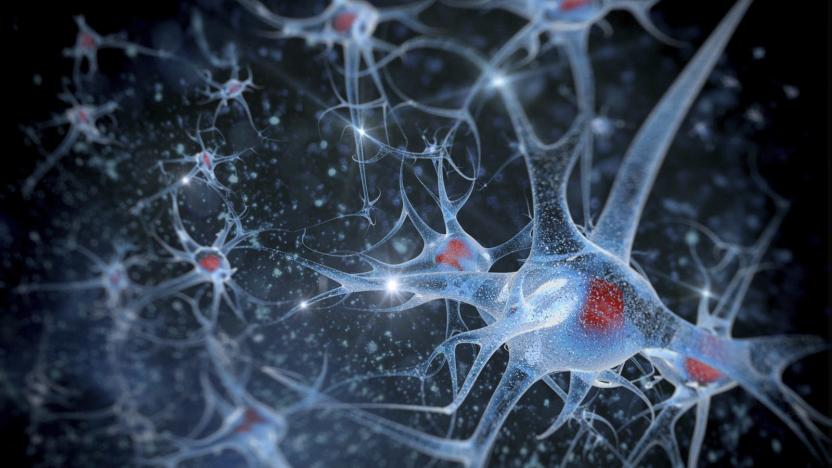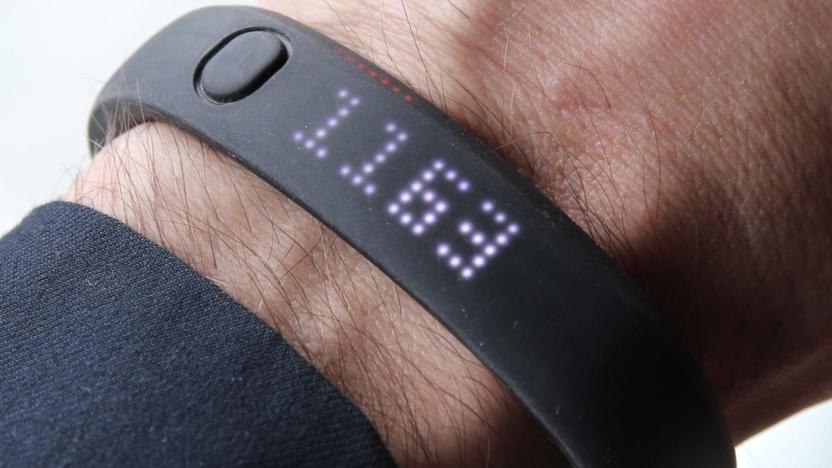synapse
Latest

Google helps publish the largest high-res map of brain connectivity
A joint effort between Google and the Janelia Research Campus has just achieved a significant breakthrough in brain mapping. They've published the largest high-resolution map of brain connectivity to date, offering a 3D model of 25,000 fruit fly neurons across a diverse range of cell types and multiple brain regions. The team achieved the feat by cutting sections of the fly's brain into ultra-thin (20-micron) slices, imaging those pieces with electron streams from a scanning electron microscope and stitching them back together. The result is a sophisticated map with so few disruptions that it's practical to trace neurons through the brain.

Nanoleaf's colorful wall tiles now act as Razer gaming controls
Nanoleaf and Razer teamed up last year to making gaming an even more immersive experience. Thanks to integrations between Nanoleaf's modular lights and Razer's Synapse IoT platform, gamers could enjoy everything from event-based flashes and explosions to instant notifications when a spell is ready to fire, all in glorious technicolor across their gaming space. Now the partnership has expanded to bring game controls to the illuminated touch-tiles, too.

'Artificial synapse' points the way toward portable AI devices
Tech titans like Intel and IBM have already begun developing chips for AI that mimic the way the human brain works -- it is, after all, the most powerful computer there is. The field of "neuromorphic computing" is still in its very early stages, though, and one of its pioneers' greatest challenges is copying neural synapses. Those are the small structures where information passes when it moves from one neuron to the next. That's why a team of MIT engineers have set out to develop an artificial synapse that works like the real deal and have successfully come up with a design that can "precisely control the strength of an electric current flowing across it, similar to the way ions flow between neurons."

Artificial synapse could be key to brain-like computing
If you're going to craft brain-like computers, it stands to reason that you'd want to replicate brain-like behavior right down to the smallest elements, doesn't it? Sure enough, researchers have managed just that. They've developed an artificial synapse that imitates the real thing by both learning and remembering whenever electrical signals cross -- most previous attempts at this can only manage one action at a time. You only have to discharge and recharge the synapse at specific voltages to program it, and it promises to be far more power-efficient than conventional approaches to brain-like operation.

Brain-like computers may now be realistic
Power consumption is one of the biggest reasons why you haven't seen a brain-like computer beyond the lab: the artificial synapses you'd need tend to draw much more power than the real thing. Thankfully, realistic energy use is no longer an unattainable dream. Researchers have built nanowire synapses that consume just 1.23 femtojoules of power -- for reference, a real neuron uses 10 femtojoules. They achieve that extremely low demand by using a wrap of two organic materials to release and trap ions, much like real nerve fibers.

Nike FuelBand designers bought by a consulting giant
Synapse, a key creator of the Nike+ FuelBand (among other gadgets), is moving on to greener pastures. Product development giant Cambridge Consultants has bought Synapse for an unspecified amount. As Cambridge's parent company Altran says, this is all about giving Cambridge a product development foothold in the American West -- it can design gear for partners ranging from the UK to Silicon Valley. It's part of a plan to double the size of Cambridge by 2020.

IBM wires up 'neuromorphic' chips like a rodent's brain
IBM has been working with DARPA's Systems of Neuromorphic Adaptive Plastic Scalable Electronics (SyNAPSE) program since 2008 to develop computing systems that work less like conventional computers and more like the neurons inside your brain. After years of development, IBM has finally unveiled the system to the public as part of a three-week "boot camp" training session for academic and government researchers.

Brain-like circuit performs human tasks for the first time
There are already computer chips with brain-like functions, but having them perform brain-like tasks? That's another challenge altogether. Researchers at UC Santa Barbara aren't daunted, however -- they've used a basic, 100-synapse neural circuit to perform the typical human task of image classification for the first time. The memristor-based technology (which, by its nature, behaves like an 'analog' brain) managed to identify letters despite visual noise that complicated the task, much as you would spot a friend on a crowded street. Conventional computers can do this, but they'd need a much larger, more power-hungry chip to replicate the same pseudo-organic behavior.

Scientists show how you can restore lost memories
It's scary to lose memories, especially in the early phases of diseases like Alzheimer's -- you're really losing part of yourself. Thankfully, researchers at UCLA may have found a way to get those memories back. They've conducted experiments suggesting that memories aren't stored in synapses, as established theory dictates. Instead, you only need to make sure that neurons are intact and that the brain can synthesize the proteins needed to form new synaptic links. In a snail, memories came rushing back after scientists stopped using a protein synthesis inhibitor that curbed synaptic growth. Those memories would have been gone forever if the synapses themselves were really the key.

Engadget Daily: IBM's brain-like chip, SexFit's sensual wearable and more!
Today, we break down the ins and outs of NFL Now, learn about SexFit's sensual wearable, investigate IBM's incredibly powerful SyNAPSE chip, ponder Siri for Mac and more. Read on for Engadget's news highlights from the last 24 hours.

IBM's new supercomputing chip mimics the human brain with very little power
A lot has changed in the three years since IBM first unveiled a prototype of its human brain-inspired SyNAPSE (Systems of Neuromorphic Adaptive Plastic Scalable Electronics) chip. That single-core prototype has now been significantly scaled up, leading to a new, production-ready SyNAPSE chip that blows past its predecessor with 1 million neurons, 256 million synapses and 4,096 neurosynaptic cores, all the while only requiring 70mW of power. Though the numbers are impressive, it's what they translate to that holds even greater prominence: the ability for devices to process various sensory data in parallel just like the human brain, by merging memory and computing.

This is what brain synapses look like in 3D
Many know that brains are inherently complex things; there are trillions of synapses converting chemical and electrical signals in a human mind. However, did you know that even those synapses are very complex? If not, it should be perfectly clear now. German scientists have used a mix of extremely high-resolution microscopes (both electron and fluorescent), mass spectrometry and protein detection to create a super-detailed 3D map of a synapse in a rat's brain. It's almost like a miniscule city -- those dots you see represent 300,000 proteins, and only a tiny portion (the glowing red patch at the bottom) is transmitting chemicals.

MIT unveils computer chip that thinks like the human brain, Skynet just around the corner
It may be a bit on the Uncanny Valley side of things to have a computer chip that can mimic the human brain's activity, but it's still undeniably cool. Over at MIT, researchers have unveiled a chip that mimics how the brain's neurons adapt to new information (a process known as plasticity) which could help in understanding assorted brain functions, including learning and memory. The silicon chip contains about 400 transistors and can simulate the activity of a single brain synapse -- the space between two neurons that allows information to flow from one to the other. Researchers anticipate this chip will help neuroscientists learn much more about how the brain works, and could also be used in neural prosthetic devices such as artificial retinas. Moving into the realm of "super cool things we could do with the chip," MIT's researchers have outlined plans to model specific neural functions, such as the visual processing system. Such systems could be much faster than digital computers and where it might take hours or days to simulate a simple brain circuit, the chip -- which functions on an analog method -- could be even faster than the biological system itself. In other news, the chip will gladly handle next week's grocery run, since it knows which foods are better for you than you ever could.

City of Heroes lays out the design for Street Justice
You could argue that City of Heroes has been about street justice since launch, since there is no branch of the US legal system that involves beating people up in the streets with electrical powers. But the Street Justice powerset is the latest addition to the game in the Paragon Market, and as with the previous powersets, a new issue of the Intrepid Informer has been released so that players can understand how the set works, what the designers were thinking, and how to get the most benefit out of it. Written by Phil "Synapse" Zeleski, the diary outlines both the similarities and differences between this set and Dual Blades. While both are combo-oriented sets, Street Justice allows you to build a combo on the fly; by way of contrast, Dual Blades generates a variety of powerful secondary effects with its combos. If the set sounds like the sort of thing that's right up your alley, you may want to pop until the game, drop a couple of dollars, and start breaking some kneecaps. For justice.

Take justice to the streets in City of Heroes
If you're not satisfied taking out thugs with merely a katana or a kick, then Paragon Studios has your answer: Street Justice. It's a brand-new powerset just released in City of Heroes Freedom, available to Scrappers, Brutes, Stalkers, and Tankers. It looks like a flashier mashup of the Martial Arts and Super Strength sets, and according to a post by Paragon's Phil "Synapse" Zeleski, Street Justice is like many of the newer CoH sets in that it comes with a special mechanic, in this case, combo levels and finishing moves that give more freedom to the player than does the similar gameplay hook of Dual Blades. Street Justice is available for purchase in the game's cash shop for 800 Paragon Points (about $10 US). It is one of two new powersets not granted freely to VIP subscribers. Check out the video after the break to peek before you buy.

City of Heroes to get frickin' laser beams [Updated]
If there's one common cry on the City of Heroes forums, it's "give us new power sets!" Fortunately, the upcoming Freedom expansion aims to deliver just that. This morning, CoH's Phil "Synapse" Zeleski offered up a new dev blog outlining one of the planned power sets, Beam Rifle. Available to Blasters and Corruptors (as a primary set) and Defenders (as a secondary set), Beam Rifle is heavy on the AoE and features a signature cascading Disintegrate effect, which can be spread to nearby enemies and causes targets to take ever more damage from the power set's attacks. In a nod to style, Synapse noted that "plasma beams from movies, games, and other sources were the inspiration for the style of beam used by this power set" and that it has "a synthetic, futuristic sound with some 'grime' added [to make it] sound powerful." In related news, Paragon Studios has reiterated that various CoH-flavored purchasables on the NCsoft store website, including the booster packs and expansion boxes, will be discontinued in advance of the looming F2P conversion. If you can't live without a Steampunk costume in the meantime, you have until August 30th to get your fix. [Update: A second dev blog outlining each of Beam Rifle's powers in-depth is also now available on the official website.]

IBM's cognitive computing chip functions like a human brain, heralds our demise (video)
After having created a supercomputer capable of hanging with Jeopardy's finest, IBM has now taken another step toward human-like artificial intelligence, with an experimental chip designed to function like a real brain. Developed as part of a DARPA project called SyNAPSE (Systems of Neuromorphic Adaptive Plastic Scalable Electronics), IBM's so-called "neurosynaptic computing chip" features a silicon core capable of digitally replicating the brain's neurons, synapses and axons. To achieve this, researchers took a dramatic departure from the conventional von Neumann computer architecture, which links internal memory and a processor with a single data channel. This structure allows for data to be transmitted at high, but limited rates, and isn't especially power efficient -- especially for more sophisticated, scaled-up systems. Instead, IBM integrated memory directly within its processors, wedding hardware with software in a design that more closely resembles the brain's cognitive structure. This severely limits data transfer speeds, but allows the system to execute multiple processes in parallel (much like humans do), while minimizing power usage. IBM's two prototypes have already demonstrated the ability to navigate, recognize patterns and classify objects, though the long-term goal is to create a smaller, low-power chip that can analyze more complex data and, yes, learn. Scurry past the break for some videos from IBM's researchers, along with the full press release.

'Pxl Pushr' blends Kinect and iPad play to impressive, multicolor results
Among the dozen or so games strewn about New York City's Museum of Modern Art (during last week's Kill Screen-curated "Arcade" event) two titles had their playable debuts: Eric Zimmerman and Nathalie Pozzi's "Starry Heavens" ("a physical game of power and betrayal"), as well as Matt Boch and Ryan Challinor's "Pxl Pushr" ("something akin to a full-bodied theremin blended with a puzzle game"). Considering what the two freshman entries were up against -- critically acclaimed games like Limbo, Canabalt, and Echochrome -- it was impressive that both games had lengthy lines throughout the evening. I mean no offense when I say this, but Pxl Pusher looks like what would've happened if Kinect technology had existed in the Coleco Vision days. In the same way that your Dad's sweet 1973 Lacoste track jacket still looks totally rad, so does Pxl Pushr. The bizarre look is both a measure of the dev duo's style -- their day jobs are as designers at Harmonix -- and of the short-term development cycle. "Over the past four weeks-ish we've been messing around building this game," Boch explained. In Pxl Pushr, one player places dots on an iPad, while another player attempts to catch as many dots as possible by using the contortions of their body (via Kinect). The player contorting their body is scored on how many pixels he/she is able to "push" versus the ones they miss. It's a simple concept for sure, but one that had many attendees smiling while making very silly poses. Not that the crowd's reaction was foreign to Boch and Challinor, two gentlemen who spend their working hours with Dance Central 2.%Gallery-129438%

Researchers build synthetic synapse circuit, prosthetic brains still decades away
Building a franken-brain has long been a holy grail of sorts for scientists, but now a team of engineering researchers have made what they claim to be a significant breakthrough towards that goal. Alice Parker and Chongwu Zhou of USC used carbon nanotubes to create synthetic synapse circuits that mimic neurons, the basic building blocks of the brain. This could be invaluable to AI research, though the team still hasn't tackled the problem of scope -- our brains are home to 100 billion neurons, each of which has 10,000 synapses. Moreover, these nanotubes are critically lacking in plasticity -- they can't form new connections, produce new neurons, or adapt with age. All told, the scientists say, we're decades away from having fake brains -- or even sections of it -- but if the technology advances as they hope it will, people might one day be able to recover from devastating brain injuries and drive cars smart enough to avert deadly accidents.

Caveat emptor: Custom Android handsets all the rage in Germany?
This isn't the first customizable phone we've laid our eyes on, and we've always been a fan of the concept -- even if the execution sometimes leaves a lot to be desired. Apparently there's a small startup residing in Germany called Synapse that will sell you a custom Android 2.2 handset, complete with 4-inch multitouch touchscreen, with prices starting around €434 ($600). We say apparently because, try as we might, we only got the Drupal-powered website to appear once this morning. Indeed, the tipster couldn't even get it to appear more than once himself, which is why he sent us a screen shot. Thanks! What we were able to see, however briefly, was a whole menu of customizable options, including radio (3G and 4G, including LTE and WiMAX), Bluetooth, WiFi, up to a 12 MP camera (with a flash or not), mini-HDMI out, various memory and storage options, and more. Not bad, eh? We don't think we'll be taking a chance on this vaporous website, but if you do, make sure you let us know how it works out. Update: Not that we've been able to access the site again, looks like the thing could be had for a baseline price of €299 (or roughly $410). Thanks to Thomas and everyone else who pointed this out! [Thanks, Christian]











